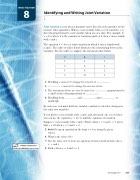Page 544 - Algebra 1
P. 544
INVES8TIGATION
Identifying and Writing Joint Variation
Joint variation occurs when a quantity varies directly as the product of two or more other quantities. When y varies jointly with a set of variables, y is directly proportional to each variable taken one at a time. For example, if y = kxz where k is the constant of variation and k ≠ 0, then y varies jointly with x and z.
The equation b = 3ac is a joint variation in which b varies jointly with
a and c. The table of values below illustrates the relationship between the variables. Use the table to complete the statements that follow.
a
b
c
1
3
1
2
6
1
1
6
2
2
12
2
1. Doubling a causes b to change by a factor of
2. c causes b to change by a factor of two.
3. The statements above are true because b is
a, and b is directly proportional to .
.
proportional to to
4. Doubling both and quadruple.
causes
Online Connection www.SaxonMathResources.com
In each case, you must hold one variable constant to calculate changes in the other two variables.
If you know y varies jointly with x and z and also know one set of values, you can use the equation y = kxz to find the equation of variation.
Suppose y varies jointly with x and z. Find y when x = 8 and z = 3, given that y = 20 when x = 5 and z = 2.
5. Model Set up an equation in the form y = kxz using the given values.
6. What is the value of k?
7. Use the value of k to write an equation of joint variation that relates
x, y, and z.
8. Find y when x = 8 and z = 3.
Investigation 8 529


